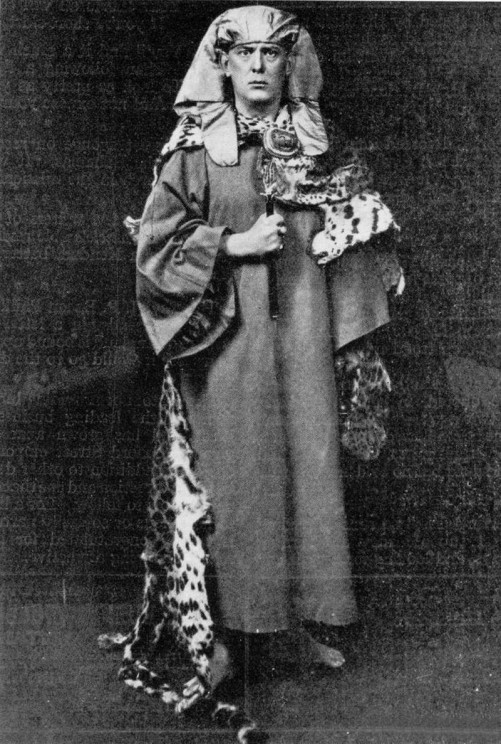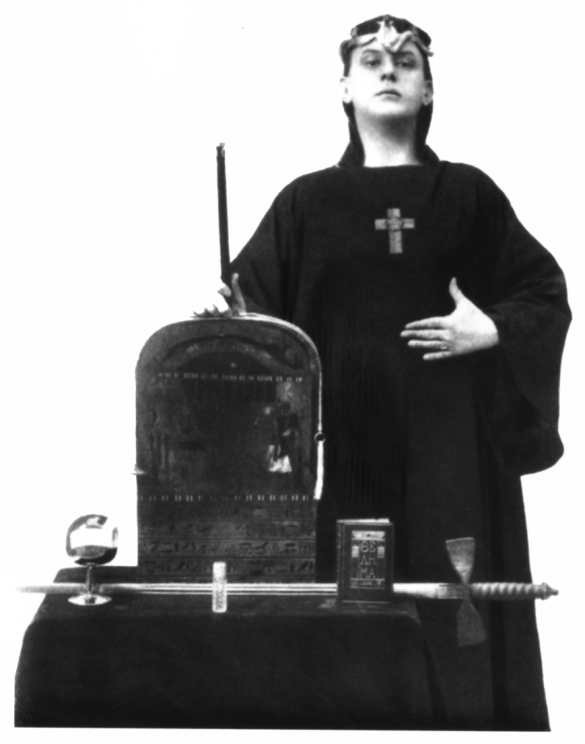Title: Disenchanted
Author Name: Leigh Goff
Genre(s): Young Adult, Fantasy, Romance, Occult
Keywords: Young Adult, Fantasy, Fantasy Romance, Witchcraft, Wethersfield, Goodchild, Mather, witch, coven, true love curse, white witch, black witch, Sophie, Alexavier, bloodcharm, star-crossed, clairvoyant, outcast
ISBNs: e-Book ~ 978-0-9947490-0-0 Print Book ~ 978-0-9920490-9-6
Number of Pages: 264
Release Date: June 1, 2015
A forbidden love. A dark curse. An impossible choice...About Disenchanted:Descended from a powerful Wethersfield witch, sixteen-year-old Sophie is struggling to hide her awkwardly emerging magic, but that’s the least of her worries. When a dangerous thief tries to steal her mysterious heirloom necklace, she is rescued by the one person she’s forbidden to fall for, a descendant of the man who condemned her ancestor to hang. He carries a dark secret that could destroy them both unless Sophie learns how to tap into the mysterious power of her diamond bloodcharm. She will have to uncover dark secrets from both of their families' wicked pasts and risk everything, including her soul to save them from a witch's true love curse, but it will take much more than that.
Excerpt:“You really want to know?” He circled behind me, not touching me, but I could feel him there, just an inch away. He stepped closer, his body heat warming my exposed neck.
I tried to ignore the trembles and craving his alluring voice provoked. Heat and tension continued to roll off him. My breathing quickened.
“Secrets never stay secret in Wethersfield. It’s going to slip out eventually.”
He circled around to face me again and nodded. “Your curiosity is inexhaustible.”
I pressed my hand to my forehead, trying to regroup, which was harder than it should have been. “Look. It doesn’t matter. I can handle whatever it is.”
“Zeke will be thrilled if he finds out what I’m about to tell you.” He shook his head, probably imagining the ugly scenario. “I come from a long line of Mathers who have been more than unlucky in love. A staggering number of them, so many that one cannot blame it on misfortune or bad luck. For years, my father thought it was a genetic fluke until he had our ancestor’s DNA tested and, like his own, it showed nothing.” He rolled his sleeve up enough to show me the pinkish birthmark on his wrist. It resembled a small heart broken in two, exactly like Zeke’s. “You see, from my father’s research, every Mather heir for centuries has carried this mark in this spot. It is something passed down in our family, inherited, but not genetic. That leaves only one explanation. Our bloodline is cursed.”
“Are you sure it’s not Karma or bad luck?” We knew Francis had been cursed for his father’s hand in the hangings. But all of them? I didn’t think a generational curse was really possible.
“I don’t believe in bad luck, but I do believe in the power of this curse. It has haunted us through time.”
“How many of you?”
“After they fell in love?Since Francis Mather, the one buried under the tree next to your ancestor, all of them. Not at first. Some of them were able to bear a child or two before their love deepened and the curse took hold of one or both of them. It is why my father used a surrogate rather than risk a relationship. He, Zeke, and I are the last of Rev. Mather’s direct descendants. It’s too many to make sense so all we are left with is the fact that we are cursed to live a life without love or die from it.”
I staggered backward, staring at the trees lining the path, in shock. Elizabeth warned me about a curse living on. The judge even sputtered on about a problem caused by the witches. Did they both mean a generational curse on the Mathers? Generational curses were only heard of in myths because they required great power and a dark heart. Did Rebecca have that much power? “Let’s say that’s even possible.” I could barely grasp the possibility for the irony got in the way. A curse cast by my ancestor meant to punish the Mathers was now threatening not only my happiness, but my life.
Mirror World Publishing Link:
DisenchantedAmazon Purchase Link:
Disenchanted
About the Author:Writing Enchanting Ever-Afters ♥

Leigh Goff grew up in Maryland where she resides today. Her writing is inspired by an unusual childhood, a vivid imagination, and compelling historical events. After taking several writing courses in college and attending professional writing workshops after she graduated from the University of Maryland, she joined the Maryland Writers' Association and Romance Writers of America. She is also an approved artist with the Maryland State Arts Council.
Learn more about Leigh Goff on her
WEBSITE or at
Mirror World Publishing.
Follow the Tour Here:
http://saphsbookblog.blogspot.com/2015/05/book-tour-schedule-disenchanted-by.html
By Alyssa Bender
The twelfth of August marks the Feast of the Prophet and his Bride, a holiday that commemorates the marriage of Aleister Crowley and his first wife Rose Edith Crowley in the religion he created, Thelema. Born in 1875, Crowley traveled the world, living in Cambridge, Mexico, Cairo, China, America, Sicily, and Berlin. Here, using Aleister Crowley and Western Esotericism as our trusted guide, we take a closer look at the man and his religion.
In 1898 Alesiter Crowley was initiated into the Hermetic Order of the Golden Dawn as Frater Perdurabo. The teachings of the Hermetic Order of the Golden Dawn were based upon an imaginative reworking of Hermetic writings further informed by nineteenth-century scholarship in Egyptology and anthropology. The order was structured around the symbolism of the kabbalah and organized into temples that were run on strictly hierarchical lines. Authority was vested in leading individuals, and initiates were given a rigorous and systematic training in the “rejected” knowledge of Western esotericism. They studied the symbolism of astrology, alchemy, and kabbalah; were instructed in geomantic and tarot divination; and learned the underpinnings of basic magical techniques.
Crowley’s magical self, Perdurabo, was a part of his concept of selfhood. In his own words:
As a member of the Second Order [of the Golden Dawn], I wore a certain jewelled ornament of gold upon my heart. I arranged that when I had it on, I was to permit no thought, word or action, save such as pertained directly to my magical aspirations. When I took it off I was, on the contrary, to permit no such things; I was to be utterly uninitiate. It was like Jekyll and Hyde, but with the two personalities balanced and complete in themselves.
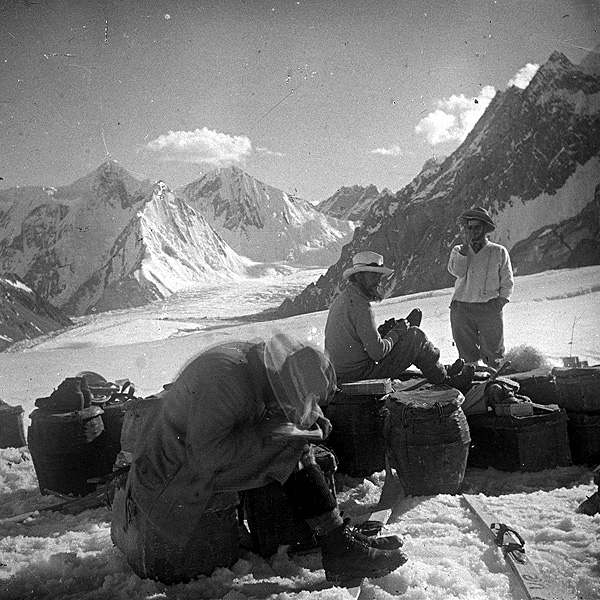
The base camp of 1902 expedition for K2. Aleister Crowley is in setted in the middle. By Jules Jacot Guillarmod. Public domain via Wikimedia Commons.
In 1902, Aleister Crowley was a part of the team who made the second serious attempt to climb the world’s second highest summit, K2.
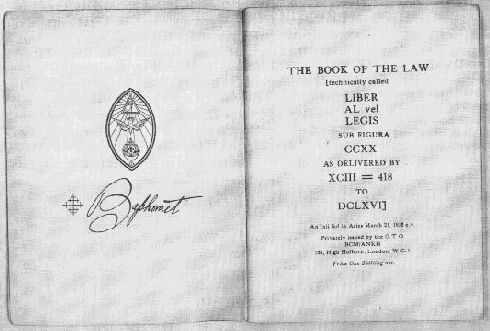
Frontpage from a published versions of Liber AL vel Legis. By Ordo Templi Orientis. Public domain via Wikimedia Commons.
In the spring of 1904, while on his honeymoon in Cairo, Egypt, he received a short prophetic text, which came to be known as Liber AL vel Legis or The Book of the Law. The book announces the doctrines of a new religion called Thelema, with Crowley—referred to in the book as “the prince-priest the Beast”—as its prophet.
The most important book of The Holy Books of Thelema, The Book of the Law is a channeled text that consists of 220 short verses divided into three chapters.
The core doctrines of this new creed of Thelema were expressed in three short dictums: “Do what thou wilt shall be the whole of the Law,” “Love is the law, love under will,” and “Every man and every woman is a star.”

Thelema Abbey in Cefalù, Sicily, by Frater Kybernetes. CC BY-SA 2.0 via Wikimedia Commons.
Thelema Abbey was established in the small Italian town of Cefalù in the period between 1920 and 1923. It consisted of one large house occupied by a small number of Crowley’s disciples and mistress(es). Life at the Abbey was for the most part Crowley’s attempt to translate his magical and Thelemic ideas into social reality. For the participants, the regime of life involved a great deal of occult and sex-magic activity as well as experiments with various mind-and mood-altering substances, such as hashish, cocaine, heroin, and opium.
Alyssa Bender is a marketing coordinator in Academic/Trade marketing, working on religion and theology titles as well as Bibles. She has worked in OUP’s New York office since July 2011.
Aleister Crowley and Western Esotericism, edited by Henrik Bogdan and Martin P. Starr, is the first comprehensive examination of an understudied thinker and figure in the occult.
Subscribe to the OUPblog via email or RSS.
Subscribe to only religion articles on the OUPblog via email or RSS.
The post Aleister Crowley and Thelema appeared first on OUPblog.

RED LIGHT PROPERTIES, now available in its first five issues through Monkeybrain Comics on Comixology, is a genre mixer with a gritty dose of realism that, for Eisner-nominated writer and artist Dan Goldman, hits close to home. Growing up in Miami, and aware of its hectic combination of cultures, crime, and mystery, Goldman ingested plenty of fodder for comics creation. A lifelong interest in the paranormal and occult has taken him down some unusual roads in storytelling, and his unlikely but all too human hero Jude Tobin couldn’t have a stranger profession: exorcist for haunted properties in Miami during the current economic slump. His methods “green light” properties that are bedeviled by hangovers from their violent pasts with a practical result of money in the pocket for our occult explorer as well as downtrodden home owners. It’s just a day in the life of a guy who ingests psychedelic substances to boost his own natural sensitivity to the spirit world in order to sell houses.
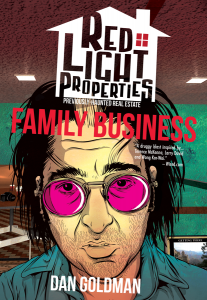
Goldman’s approach to comics storytelling establishes belief in a number of intriguing ways. Not only does Goldman emphasize the personal relationships in Jude’s life, dealing with a live-in ex wife who still has feelings for him, a step-son who is starting to display his own occult abilities, and wrestling with his own personal demons including his dead father’s ghost, but he also explores a relationship crux in the stories of many of the haunted properties. Many of the darkest emotions that haunt “red light” real estate spring from love and loss, and owners themselves benefit from Jude’s exorcisms by making peace with traumas in their past. Add to that the artistic methods that Goldman pursues, including use of photography and digital imaging, as well as increasingly experimental page layouts, and RLP delivers a hefty sense of realism alongside its phantasmagorical subject matter.
RLP has been a long-term project for Goldman as an indie creator, and he’s particularly enthused that the comic has now found a home at Monkeybrain. It’s the kind of comic that naturally makes you want to fire questions at the creator. It’s the equivalent of seeing a circus performer pull off a remarkable high-wire act while juggling weighty and disparate materials to create a unique spectacle. You want to ask, “How on earth did you do that?”. But I tried to ask him a few intelligent questions rather than just gawking at his handiwork.
HM-S: How did you come up with the unusual concept for RED LIGHT PROPERTIES?
Dan Goldman: It comes from the collision of a few things kicking around my head for many years: waking up at night and feeling someone watching you from the empty hallway, listening to my mom rattle off war stories of Miami real estate drama for twenty-odd years, my own experiences growing older in this body while trying to figure life out. I was working RLP for nine years before I drew the first page, trying to develop my visual style because the characters were already walking around in my head and I needed the chops to do them justice.
Red Light Properties’ owner/shaman Jude Tobin serves a dark mirror for me, person I’ve looked deep into and decided I don’t want to be. He comes off as an asshole but he’s really just misunderstood with bad communication skills. He and his family are utterly real to me, and that makes RED LIGHT PROPERTIES a great platform stand on and poke all these ideas about life and death and love and consciousness and failure, all using the language of comics.

HM-S: I notice that the setting is not only Miami, but multi-ethnic. What does this bring to the comic for you?
DG: The whole world is multi-ethnic now, I’m just reflecting it. The world grows richer and more interesting in places where cultures bump up against each other. I grew up in Miami, where the series takes place, before I ever traded it for New York City (or more recently São Paulo). All three of these cities are massive destinations for immigrants. It’s how I’ve always seen the world, so it’s only natural that it’s a part of this one too.
HM-S: Has researching the occult and haunted property taken you into some strange places mentally or physically, or is the background for the work purely imaginative?
DG: I’ve been researching the occult/paranormal since I was a boy. My grandfather died right after my fifth birthday and I used to see him around the house for years. After he passed, my mother shared with me something she’d read about Peter Seller’s death experiences during a heart attack and it just sunk down into my consciousness, emerging again around the time I got a library card. I think it was the same summer GHOSTBUSTERS came out. I was a weird little nerdling then; I used to ride my bike to the library during the summer (they had cold A/C) and I stayed mostly in the back aisle of the library, poring over musty old spirit photography books.
So whether it’s perception or just my overactive imagination, I’ve been plenty of places that made me feel things and theorize about them: my brother lived in an apartment that made my skin crawl the moment I set foot there. It turned out that the landlady’s sister committed suicide and she kept her ashes in a box in top of the closet (while he lived there). There are always touches everywhere I went and sensitivities to energies that I’ve been aware of… and whenever I dug deeper, usually found a cool story in answer to my questions.
That desire for the underlying pattern that explains how life/death works is where Jude Tobin comes from.
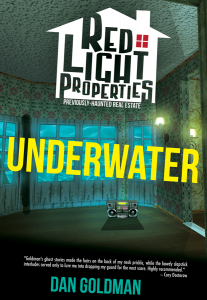
HM-S: Jude is a pretty extreme character who appears to struggle with a reason to live, “whacked out on drugs and living with ghosts”. What is it about Jude’s character that appeals to you and how do you think he appeals to readers?
DG: Jude’s tragedy is that he needs to take hallucinogenic drugs to fully access the spirit world and accomplish exorcisms, which is rough on the body and the mind. Cecilia asks this of him on a daily basis, knowing that it keeps him straddled between the living and spirit worlds… but without his work, they’re just another real estate agency in a depressed market. It’s Jude’s talent that drives the office, and she’s determined to be successful, even though she knows it comes at a huge price for her family.
He appeals to me because as any cartoonist knows, when you sit down to draw pages, you’re separated from everyone else’s world, coming up for air to eat with your loved ones and get a little rest. To Jude, his shamanism is a kind of art, so I relate to him artist-to-artist. I think that’s clear to readers too.
HM-S: Jude seems to have a sensitivity to the supernatural without the use of drugs, but he uses them to boost his consciousness, often further than he expects. Do you find it difficult to depict these kinds of altered states in comics form?
DG: Yes, as a baseline, Jude was born with a sensitivity to spirits. He knows when they’re around and can sometimes see them, but he needs a heavy entheogenic agent from his toolkit to amplify his abilities enough to project himself into the spirit realm and interact with them directly. There’s a whole logic to the way ghosts function in relation to the life/death membrane that I get into the book and how Jude’s drug-mixes relate to that.
Is it difficult to depict? Yeah. But it’s also the most fun part of drawing RLP. I love weird brain-melty comic page designs and surreal storytelling dropped in the middle of mostly-realistic stuff, so Jude’s work-trips are a perfect excuse for me to let any story off the leash and maul the reader’s eyeballs for a while.

HM-S: What about this comic makes you want to write and draw it?
DG: The initial germ started off as metaphysical questions but now all these characters are ALIVE IN MY HEAD AND THEY HAVE TO GET OUT. Getting the first chunk of the story done was literally a release of a decade’s worth of pressure in my skull — trepanning by comics — but the more I tickle them to understand their life stories, the more the whole story starts growing. I think I’m gonna be at this a while…
HM-S: What’s it like both drawing and writing the comic? Are there pros and cons to being your own creative team?
DG: The drawing for me is a lot hard harder than the writing, which just kinda flows out of me when I sit down. The art — especially getting it just the way I want it — is a brutal process, like squeezing juice out of oranges until there’s just nothing left. I’m always destroyed at the end of a story. It also takes longer; I think I’d be much more prolific if I worked with artists and just worried about the script… but I don’t know anyone who can do RLP the way I do it.
HM-S: I notice the use of photographs blended with artwork. Is that a form you think is particularly suited to comics?
DG: It’s just a style that I’m playing in; RED LIGHT PROPERTIES actually combines photography and rendered 3D models and digital artwork together into its comic pages. I’m comfortable using whatever tools are at my fingertips to give the stories the most impact I can.
Comics are a fluid and evolving medium anyhow, stories made using words and pictures. I have zero patience with anyone who insists otherwise; I just smile and nod as they tell me about which Windsor & Newton brush they like best.
HM-S: While there’s the overarching theme of the occult and supernatural, relationships seem to be a major focus of the series, from Jude and his ex-wife Cecilia, to the stories behind the properties. What role do you think relationships play in the comic?
DG: The relationships are everything in RLP because that’s what makes characters worth caring about. I purposefully make their little tensions and joys as dramatic than the supernatural events, things that would be horrifying to us but they’re totally desensitized to after years in the business. That’s interesting to me as a creator and reader: I want to know what this kind of work, and what trying find meaning in the living world while surrounded by spirits of the dead feels like.
Where the casework, the haunted properties, come in is to ground every ghost stories in something human. Having a poltergeist throwing dishes around is neat visually but it’s got no emotional meat to it. When you find out the tragic reasons and complicated metaphysical structures behind those flying dishes and how to “treat” the house, suddenly the scenario demands more of your attention than just a Hollywood BOO!-type scare.
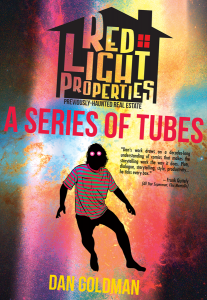
HM-S: A lot of the more seemingly fantastic elements of the comic, from occult rituals to bizarre murder cases, are actually pretty firmly grounded in reality, aren’t they? What do you think is the value of talking about subjects like pedophilia, murder, and the afterlife?
DG: Placing RLP in the “real world” demands that, doesn’t it? Miami is a violent and vapid city where crazy things happen every day, and these good and bad things are all part of human experience. When you’re delving into the reasons why spirits linger in a structure, that’s historically been the explanation for hauntings (though I’ve got a doozey coming up that gets into the inverse of that).
What draws me to telling ghost stories (versus, say, zombies) is that they’re not just the shells that remain of who we were but echoes of the dreams and experiences that aren’t ready to let go, for whatever reason. And the spectrum of reasons behind that is rich material to tell all kinds of stories with.
HM-S: I notice that “A Series of Tubes”, issue #5, really branches out in terms of panel design. In creating and designing the artwork for the comic, have you had any surprises or discoveries?
DG: I’m so happy you brought that up. I’m very proud of A SERIES OF TUBES… I’m not sure what started happening there, maybe I just really let myself go with those layouts and got all free-jazz with them. The end result is a direction I’m continuing to push in with the new stories I’ve been working on.
The biggest discovery that came from that was how little of it was conscious. I’m a heavy full-scripter and a very loose sketcher, and when I finished the story and read it, I was transported, like I was reading someone else’s work. That’s a good sign to me.

[Photo by Seth Kushner]
HM-S: So what’s the history of RED LIGHT PROPERTIES in terms of production? How did it end up at Monkeybrain?
DG: In the three years I’ve been creating this series digitally, I’ve stayed free enough approach the series from different directions without being locked down to a single format or system. RLP started off as a free publisher-sponsored webcomic serial, it became DRM-free digital issue downloads on its own site, and now it lives at Monkeybrain Comics as an exclusive part of Comixology.
It was always the intention to tell these characters’ stories in an ongoing series like this, though at launch I saw it as a series of graphic novels because the digital marketplace hadn’t really happened yet. This whole time, I’ve been watching my creator friends having a blast in a floppy-to-trade world, and I’ve developed a really intense case of “ongoing series envy.” Until now, all my books have been for the book trade; the only time a comics publisher has ever published my work was a 4-pager I had in Image’s POPGUN anthology. But comics are born from serializing, designed for series. In the book trade, it’s something they’ve learned from us and had great success with. So when it came time to make a new change, doing an ongoing series of digital issues seemed like the cleverest route. No shipping delays, shortages, returns, or waiting on the publisher.
And in the digital-first series world, becoming part of Monkeybrain Comics was an obvious choice. They speak fluent internet. They’re the tiny mammals eating dinosaur eggs, poised to inherit the landscape. That’s something was already a part of, but we are stronger together. Being able to publish easily and quickly to Comixology in multiple languages on all major platforms (except videogame consoles, right boys?) means I’m maintaining almost as much control as I had rolling solo, but now I’ve got distribution and discovery on my side as well. It’s a huge flaming sword to cut through the noise with.

[Photo by Seth Kushner]
HM-S: What’s coming up for RED LIGHT PROPERTIES? What are you most excited about?
DG: Word of mouth around Miami is going to bring the Tobins a lot more success and attention than they’re prepared to handle, which is going to cause all kinds of problems for them, professional and personal. There’s a long road ahead for Jude and Cecilia, and I’ve got many stories in the can, just waiting to get out.
Presently, I’m finishing up the remastering work on the existing part of the series, making the early pages and script the best I can before releasing them as digital issues through Monkeybrain. There are print collections coming too but it’s not the time to announce anything just yet.
I’m probably most excited about finally seeing these characters in print; for three years, I’ve been watching them jump screens with nothing new for comic shops or book stores or my table at conventions. That’s all going to change soon, and it’s gonna be glorious.
HM-S: Thanks for the in-depth insights, Dan! You do realize that you’re going to make all your readers think twice before buying a new house, don’t you? Well, we know who to call, at least.
Hannah Means-Shannon writes and blogs about comics for TRIP CITY and Sequart.org and is currently working on books about Neil Gaiman and Alan Moore for Sequart. She is @hannahmenzies on Twitter and hannahmenziesblog on WordPress.

Owen Davies, professor of social history at the University of Hertfordshire, has written extensively about the history of magic, witchcraft and ghosts. His most recent book, Grimoires: A History of Magic Books, is a history of magic books that takes us from ancient Eygpt, through Kabbalah, Scandinavian witchcraft, 19th-century Egyptology, West African folk religion, a Chicago mail-order charlatan whose books are still banned in Jamaica today, and - of course - Buffy the Vampire Slayer. In the post below, which originally appeared on The Guardian’s website, Owen Davies chooses his top 10 grimoires.
“Grimoires are books that contain a mix of spells, conjurations, natural secrets and ancient wisdom. Their origins date back to the dawn of writing and their subsequent history is entwined with that of the religions of Judaism, Christianity and Islam, the development of science, the cultural influence of print, and the social impact of European colonialism.”
1. The Sixth and Seventh Books of Moses
Although one of the more recent grimoires, first circulating in manuscript in the 18th century, this has to be number one for the breadth of its influence. From Germany it spread to America via the Pennsylvania Dutch, and once in cheap print was subsequently adopted by African Americans. With its pseudo-Hebraic mystical symbols, spirit conjurations and psalms, this book of the secret wisdom of Moses was a founding text of Rastafarianism and various religious movements in west Africa, as well as a cause célèbre in post-war Germany.
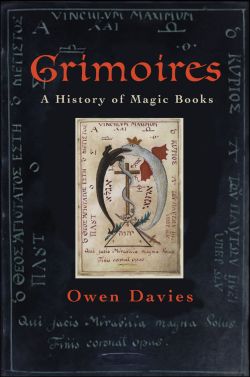 2. The Clavicule of Solomon
2. The Clavicule of Solomon
This is the granddaddy of grimoires. Mystical books purporting to be written by King Solomon were already circulating in the eastern Mediterranean during the first few centuries AD. By the 15th century hundreds of copies were in the hands of Western scientists and clergymen. While some denounced these Solomonic texts as heretical, many clergymen secretly pored over them. Some had lofty ambitions to obtain wisdom from the “wisest of the wise”, while others sought to enrich themselves by discovering treasures and vanquishing the spirits that guarded them.
3. Petit Albert
The “Little Albert” symbolises the huge cultural impact of the cheap print revolution of the early 18th century. The flood gates of magical knowledge were opened during the so-called Enlightenment and the Petit Albert became a name to conjure with across France and its overseas colonies. As well as practical household tips it included spells to catch fish, charms for healing, and instructions on how to make a Hand of Glory, which would render one invisible.
4. The Book of St Cyprian
Grimoires purporting to have been written by a legendary St Cyprian (there was a real St Cyprian as well) became popular in Scandinavia during the late 18th century, while in Spain and Portugal print editions of the Libro de San Cipriano included a gazetteer to treasure sites and the magical means to obtain their hidden riches. During the early 20th century, editions began to appear in South America, and copies can now be purchased from the streets of Mexico City to herbalist stalls high in the Andes.
5. Dragon rouge
Like the Petit Albert, the Red Dragon was another product of the French cheap grimoire boom of the 18th century. Although first published in the following century, it was basically a version of the Grand grimoire, an earlier magic book which was infamous for including an invocation of the Devil and his lieutenants. The Dragon rouge circulated far more widely though, and is well known today in former and current French colonies in the Caribbean.
6. The Book of Honorius
Books attributed to Honorius of Thebes were second only to those of Solomon in notoriety in the medieval period. In keeping with a strong theme in grimoire history, there is no evidence that an arch magician named Honorius lived in antiquity - as manuscripts ascribed to him stated. Through prayers and invocations, books of Honorius gave instructions on how to receive visions of God, Hell and purgatory, and knowledge of all science. Very handy.
7. The Fourth Book of Occult Philosophy
Cornelius Agrippa was one of the most influential occult philosophers of the 16th century. He certainly wrote three books on the occult sciences, but he had nothing to do with the Fourth Book which appeared shortly after his death. This book of spirit conjuration blackened the name of Agrippa at a time when the witch trials were being stoked across Europe.
8. The Magus
Published in 1801 and written by the British occultist and disaster-prone balloonist Francis Barrett, The Magus was a re-statement of 17th-century occult science, and borrowed heavily from an English edition of the Fourth Book of Occult Philosophy. It was a flop at the time but its influence was subsequently considerable on the occult revival of the late 19th century and contemporary magical traditions. In the early 20th century a plagiarised version produced by an American occult entrepreneur and entitled The Great Book of Magical Art, Hindu Magic and East Indian Occultism became much sought after in the US and the Caribbean.
9. The Necronomicon
A figment of the ingenious imagination of the influential early 20th-century writer of horror and fantasy HP Lovecraft, this mysterious book of secret wisdom was penned in the eighth century by a mad Yemeni poet. Despite being a literary fiction, several “real” Necronomicons have been published over the decades, and today it has as much a right to be considered a grimoire as the other entries in this Top 10.
10. Book of Shadows
Last but not least there is the founding text of modern Wicca – a pagan religion founded in the 1940s by the retired civil servant, folklorist, freemason and occultist Gerald Gardner. He claimed to have received a copy of this “ancient” magical text from a secret coven of witches, one of the last of a line of worshippers of an ancient fertility religion, which he and his followers believed had survived centuries of persecution by Christian authorities. Through its mention in such popular occult television dramas as Charmed, it has achieved considerable cultural recognition.







